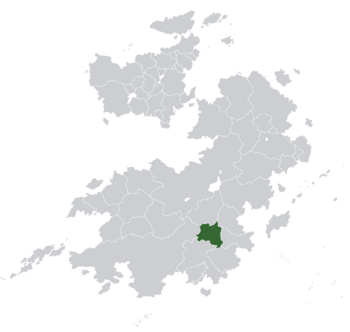Zomia: Difference between revisions
No edit summary |
No edit summary |
||
| Line 73: | Line 73: | ||
Since the collapse of the United Zomi Councils in the 1970s, an ethnic Kyu socialist insurgency has been active in the Southeast, and since the early 2000s various political Irfanist movements have developed in the predominantly Oegun Northwest. Since its inception the Union has ranked highly on international watchlists for terrorism and corruption, and there have been allegations by foreign observers of civil rights abuses by royalist Hsan-Lue militias. Zomia is annually ranked 'not free' by the [[International Council for Democracy]]. | Since the collapse of the United Zomi Councils in the 1970s, an ethnic Kyu socialist insurgency has been active in the Southeast, and since the early 2000s various political Irfanist movements have developed in the predominantly Oegun Northwest. Since its inception the Union has ranked highly on international watchlists for terrorism and corruption, and there have been allegations by foreign observers of civil rights abuses by royalist Hsan-Lue militias. Zomia is annually ranked 'not free' by the [[International Council for Democracy]]. | ||
[[Category:Kylaris]] | [[Category:Kylaris]] | ||
[[category:Countries (Kylaris)]] | |||
Revision as of 18:05, 16 June 2021
This article is incomplete because it is pending further input from participants, or it is a work-in-progress by one author. Please comment on this article's talk page to share your input, comments and questions. Note: To contribute to this article, you may need to seek help from the author(s) of this page. |
Union of Zomia ပြည်ထောင်စု သျှမ်
(Lue) Pyidaunzu Hsan | |
|---|---|
 | |
| Capital | Yotkuy |
| Largest city | Jattasey |
| Recognised regional languages | |
| Ethnic groups |
|
| Religion |
|
| Demonym(s) | Zomi |
| Government | Federal Elective Absolute Monarchy |
• Prince Paramount | Nyapkthe III Uo Sthe |
• Viceregnant | Badithirat I Na Israt |
| Legislature | Trucial Assembly |
| Formation | |
• Demarcation of the Trucial Territory of the Northern Chieftaincies | 30th May 1881 |
• Declaration of the United Councils | 11th June 1965 |
• Reformation of the Trucial Assembly | 29th January 1966 |
• Declaration of the Union | 1st March 1970 |
| Area | |
• Total | 694,772 km2 (268,253 sq mi) |
| Population | |
• June 2021 estimate | 19,357,609 |
• Density | 32.3/km2 (83.7/sq mi) |
| GDP (PPP) | 2020 estimate |
• Total | $85.824 billion |
• Per capita | $3,734 |
| GDP (nominal) | 2020 estimate |
• Total | $29.830 billion |
• Per capita | $854 |
| HDI (2020) | 0.531 low |
| Currency | Kyaw (ƙ) |
| Driving side | left |
| Internet TLD | .hs |
Zomia, officially the Union of Zomia (Lue: ပြည်ထောင်စု သျှမ်, Pyidaunzu Hsan) is a landlocked state in Southeast Coius. Zomia is bordered by Shangea in the Northwest, Kuthina in the Southwest, and Lavana in the Northeast. Though predominated by arid highlands, Zomia has a highly diverse geography, including seasonal tropical forest, subalpine forest, fertile intermontane valleys and open steppe along its Northern borders. It is a multi-ethnic, multi-lingual, multi-religious and multi-cultural state, with no official language and over a hundred recognised tribal minorities.
The Union is an elective monarchy formed from a federation of nine princely states and thirteen chieftaincies. Each principality is governed by a hereditary Sah, and each chieftaincy by a Thôsi, elected by a regional assembly. Together they constitute the Trucial Assembly, the unicameral legislature of the Union. An advisory panel elected by direct popular vote serves a consultative role.
Since the collapse of the United Zomi Councils in the 1970s, an ethnic Kyu socialist insurgency has been active in the Southeast, and since the early 2000s various political Irfanist movements have developed in the predominantly Oegun Northwest. Since its inception the Union has ranked highly on international watchlists for terrorism and corruption, and there have been allegations by foreign observers of civil rights abuses by royalist Hsan-Lue militias. Zomia is annually ranked 'not free' by the International Council for Democracy.

